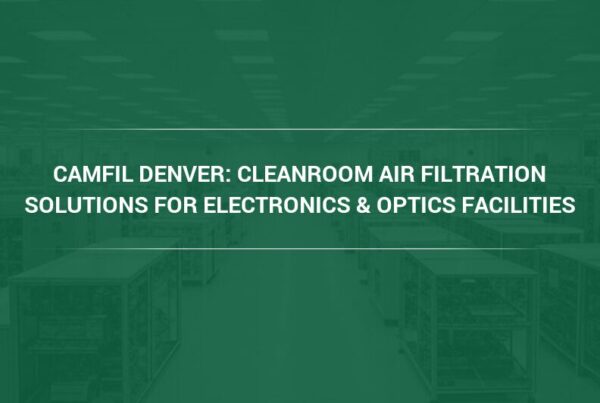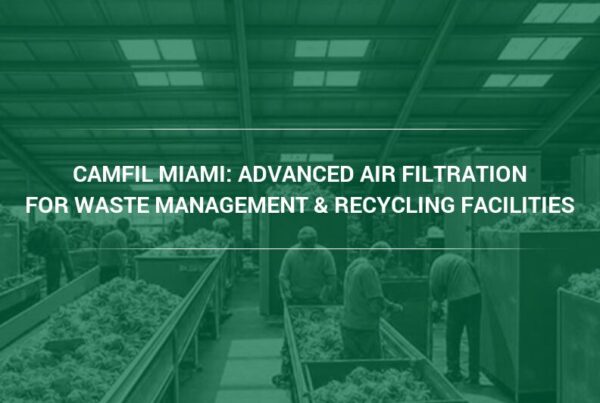Good indoor air quality leads to the better health and productivity of employees and staff. So how can you determine the best air filter efficiencies for commercial buildings? If you are considering the installation or upgrading of an air filtration system in a commercial building, this guide will provide you with the information you need to get started.
The decision to install or upgrade air filtration systems should not be made lightly, it should be made with full knowledge of the considerations that impact air filter efficiencies for commercial buildings. In order to ensure that air pollutants are effectively captured and removed from the air, you must ensure that your filtration system is properly maintained and installed. Be sure that all relevant staff and personnel is informed with the requisite information regarding air filtration systems, and that installation and maintenance is done only by qualified professionals. You will also want to take into consideration the cost of the system, the best-operating conditions for the system, and the system’s efficiency at removing particulate air pollution.
How to Make an Educated Decision about Air Filter Efficiencies for Commercial Buildings?
Making an educated decision about air filter efficiencies for commercial buildings involves obtaining the correct information on all relevant considerations. You’ll need to understand the differences between the types of air filters, and how the different filters absorb particles with different levels of efficiency.
Good air filtration systems will be able to reduce levels of indoor air pollutants and protect workers from the flu and colds. Not all air filters are created equal. All air filters are given a “Minimum Efficiency Reporting Value” or MERV. The higher the number, the more particles are filtered out but the less air passes through the filter. You will want to find a balance of air resistance and particle capture.
MERV 1-4 are typically cheap and disposable fiberglass filters, which let a lot of air through but are less efficient at capturing particles. MERV 5-8 include pleated filters and media panels. MERV 9-12 are extended pleated panels, and MERV 13-16 are electronic filters. You’ll want to check with a professional to decide the right type of filter for your commercial building.
Informed decisions about the best air filter efficiencies for commercial buildings should include considerations about implementation costs, the efficiency of the particulate air filters, and the operating conditions of the HVAC system. The better a filter is, the more expensive it will be. Though investing in an expensive filter could save you money in the long run, since it needs to be replaced less often.
What Are the Costs of Commercial Air Filtration Systems?
The costs of commercial air filtration systems may be deceptive at first glance. It’s important to look beyond the cost of the filters themselves, and consider all associated costs for the operation of a commercial air filtration system. You’ll need to consider all the potential costs including the cost of installation and removal, the cost of energy consumption, and even the cost of disposal.
A cheaper filter might look more appealing at first, but because they clog easier, the HVAC system has to spend more energy pushing the air through the filter which increases operational costs. Filters also degrade and suffer performance loss over time, meaning you’ll need to replace them at some point. A more expensive filter has a higher initial price point, but it can easily pay off over the long run. It won’t clog as quickly, and it will work for a longer amount of time before it must be replaced. More replacements mean paying higher labor costs for replacements and paying more costs for disposal as well.
Camfil has a guide to accounting for the total cost of ownership for commercial air filtration systems.
What Are the Optimal Operating Conditions for Commercial Air Filter Systems?
In terms of the optimal operating conditions for commercial air filter systems, the EPA’s guide to indoor air quality suggests that building pressure is taken into account when analyzing the effectiveness of a filtration system. Holes in the building envelope, as well as the layout of the building and pressure relationships, must be accounted for when planning for the installation of a commercial air filter system. (1)
Openings in the envelope of a building, such as small holes in the walls and cracks under doors or ceiling will change the air pressure in the building, making your HVAC system less efficient. You should remember that air filtration systems by themselves cannot improve air quality in a commercial building, it must be combined with intelligent maintenance and construction practices. Office furniture and partitions should be placed with an understanding of the HVAC system, and heat producing equipment shouldn’t be left near HVAC sensors. If a wall or support pillar is erected in front of where a vent would be it will make it harder for the HVAC system to do its job, and sensors accidentally being triggered by heat-producing equipment can cause the building to cool prematurely.
What Is Particulate Air Filtration?
Particulate matter (PM) refers to a mixture of very small particles and liquid droplets in the air, and particulate air filtration refers to the removal of these fine particles from the air via either electronic or mechanical means. Once these particles are inhaled, they can harm people’s lungs and hearts, and lead to the development of serious health problems like lung disease and cancer.
The EPA states that particle pollution is usually divided into threeseparate categories, PM10 which includes inhalable particles smaller than 10 µm in diameter, PM2.5 which refers to fine inhalable particles smaller than 2.5 µm and PM1 which refers to particles less than 1 micron in size. Ten micrometers is one-tenth the width of a single human hair, and PM10 includes things like pollen, dust, and mold. Particles smaller than 2.5 micrometers are called “fine particles” and include particles released by all kinds of combustion as well as organic compounds and certain metal particles. Common sources of PM2.5 include power plants, motor vehicles and residential wood burning in fireplaces. PM1 are by far the smallest particles, sub-micron in size and by count make up over 98% of all particles in the air. The American National Standards Institute has set standards for air filters, and High-Efficiency Particulate Air (HEPA) filters remove approximately 99.97% of particles 0.3 µm in diameter and smaller. (2)
In terms of the different kinds of air filters that will remove particulate matter, there are both mechanical and electronic air filters. Mechanical filters reduce air pollution by capturing particles in filter materials, while electronic air cleaners make use of electrostatic attraction to ionize and trap charged particles. Mechanical filters frequently need to be replaced more often than electrostatic air filters, but electrostatic filters often don’t capture larger particles and some of them can emit hazardous amounts of ozone as a byproduct. Electronic air cleaners also require periodic cleaning, an added maintenance expense.
What Are Some of the Emerging Technologies of Commercial Building Air Filters?
Mini-pleat V-cell filters are one of the most promising recent air filtration innovations, being an emerging technology of commercial building air filters. Unlike regular HVAC filters, which reduce air pressure as they get more proficient at filtering out particles, the mini-pleat V-cell filters can filter out a greater amount of particles with a very low resistance to airflow. The 1-inch mini pleat panels are arrayed in a ‘V’ formation, which gives the filters a higher surface area. This, in turn, creates less airflow resistance.
Photocatalytic Oxidation Cleaners are another emerging technology. They work by hitting pollutants with ultraviolet light, rendering biological pollutants harmless, though they don’t remove particulate pollutants from the air…They are also very limited because of the required residence time of the particle within the light field which can be very restricted because of the fast airflow through the system.
The CDC recommends that before committing to emerging filter technologies, you identify data showing the efficacy of the system and that you investigate any long-term maintenance issues associated with using an experimental system.
How to Install Commercial Air Filtration Systems?
It is important that you properly install commercial air filtration systems, as improper installation can impact the efficiency of the system. If an HVAC system is not properly installed into the building’s filter holding mechanism, filter bypass may happen. Filter bypass is where the air is able to move around the filter through a gap between the frame and the HVAC system, instead of passing through it. Filter bypass represents a worst case scenario for an HVAC installation, as it essentially completely negates the point of your filtration system, dramatically reducing the efficiency of your system. Likewise, it is important to use the correct type of air filter holding clips and gasketing material sealing the surface of the filter against the frame. If the wrong type of holding clips for the filter or the wrong gasket material is used, air could flow around the filter or the filter could come loose or fall to the side, also allowing air to bypass the filter.
When installing the system it is also important to make sure the system is free, and remains free, of dirt or moisture. Dirt and moisture in your HVAC system will lead to the clogging of filters faster. The improper installation of duct liners or boarding can lead to the development of mold. Duct liners and boarding are intended to stay dry, and if parts of them are exposed to the outside world they can get wet, prompting mold to grow. lt is also important to de-grease metal air ducts. The metal that is used for ducts often comes with a grease coating that is intended to protect from corrosion. However, this grease can sometimes trap dirt particles in the system, so make sure ducts are degreased before they are installed.
What Are Other Things to Consider about Commercial Air Filter Systems?
Inappropriately installed systems or systems with missing components will reduce the efficiency of your HVAC system, and subsequently impact the health and productivity of the occupants of the building. For this reason, it is important to ensure installation and maintenance are handled only by trained professionals.
Be sure to have building operators and technicians conduct regular inspections to ensure the system is operating normally and efficiently. When doing life cycle costs, maintenance plans can be created at the same time to help set scheduled maintenance periods. Inspections and maintenance could be set for every month, and the price incorporated into lifecycle estimates. When changing out filters it is important to remain safe at all times. Follow the relevant OSHA guidelines when changing filters or doing any other work with HVAC systems.
What Are Our Final Thoughts on Air Filter Efficiencies for Commercial Buildings?
Selecting the right air filter efficiencies for commercial buildings is pivotal for the health and productivity of those who occupy the building. Ensure that your filtration system is correctly installed and maintained only by those who have had training in HVAC system maintenance. Take the full operating costs of the system into consideration, and ensure your system is operating in the optimal conditions for peak efficiency. Finally, consider the use of indoor air quality meters. Air quality meters measure things like levels of particles in the air and can be employed to regularly check that levels of indoor air pollutants are at or below the safety standards set by cognizant authorities. If pollutant levels are above minimum safe levels or are increasing, that will indicate your HVAC system is not performing properly.
SOURCES
https://www.epa.gov/indoor-air-quality-iaq/office-building-occupants-guide-indoor-air-quality#about
https://www.epa.gov/pm-pollution/particulate-matter-pm-basics#PM
https://www.cdc.gov/niosh/docs/2003-136/pdfs/2003-136.pdf
https://www.osha.gov/pls/oshaweb/owadisp.show_document?p_table=standards&p_id=12716



